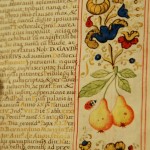
To the graduating class of 1684…
On June 3, the University of Manitoba will host its 135 Spring Convocation, awarding well-earned degrees to students on the Fort Garry campus (Medicine held its convocation on May 15).
These diplomas and what they represent are invaluable.
Those wanting to see a different sort of diploma, though, should take the short walk from the ceremony’s hall and arrive at the U of M’s Archives and Special Collections in the Dafoe Library.
The Archives possess a Padua Diploma of 1684. It was recently joined by another older diploma of the same style and there is a fascinating story of how it got to the U of M.
The 1684 diploma from the University of Padua (Padova) is a Doctor of Canon Law diploma presented to Gaudentius Carnerius on January 31, 1684. This document was part of a donation of 69 historic imprints selected by President A.H.S. Gillson and given to the University of Manitoba’s Elizabeth Dafoe Library in 1953. The collection was named after Chancellor Andrew K. Dysart. The “Carnerius” diploma (Dysart Collection #7) is an illuminated manuscript on vellum with words in letters of gold. Each page is surrounded by a decorative border composed of flowers, insects, birds, fruit and foliage.
On the first leaf is a miniature portrait of the recipient and the last page contains his coat of arms. The diploma is bound in red morocco with gilt tooling, and attached is the wax seal of the University of Padua within a red morocco container.

In late 2011 the Archives was very fortunate to receive another similar diploma as a donation from Betty Braaksma, a librarian at the University of Manitoba. The new acquisition is also a Doctor of Law diploma, presented to Ioannis Baptistas Cisteninus in 1656, nearly 30 years before the “Carnerius” diploma. It consists of 6 vellum leaves, with Latin text describing the courses taken written in black and gold, resulting in 12 pages, 10 of which are illuminated. The diploma is ornately decorated with floral and vine borders, and includes miniatures of the Virgin Mary, the Christ child, a shepherd, brightly coloured birds, including peacocks, and a very odd pair of winged cherubs with detached heads and missing lower bodies. There is a blank space in the page where the portrait of the graduate would have been. It has been reasoned that the Cisteninus diploma was probably produced by the same “scribal studio” as the Carnerius diploma, as judged by the realistic and beautiful miniatures of birds and people.
The lure of yore
The journey which resulted in the acquisition of the Cisteninus diploma of 1656 began in 2008/09. As a longtime student of medieval arts and culture, Ms Braaksma became interested in the Carnerius diploma of 1684 not only because of the document’s beauty, but also because the unusual format and illustrations raised a lot of questions for her: Why was it so elaborately decorated? Why did a seventeenth-century document resemble earlier medieval manuscripts? Who was the artist? Were the flower and plant motifs decorative or symbolic? What could be discovered about the recipient? Was this type of diploma unique among the universities of Europe? To answer these questions Ms Braaksma took a research leave in 2008/09 which allowed her to dig deeper into the Carnerius diploma and its origins. Through extensive online research as well as visits to libraries and museums (and even one collector’s residence) in Europe, she discovered that there are about 100 similar documents scattered in collections around the world, and that they have not been extensively studied.

While this study leave answered some of Ms. Braaksma’s questions, they also raised more and she continued to research the story of the Padua diplomas. In 2010 she discovered an online antiquarian bookseller located in the hills of West Virginia who had a Padua diploma from 1656 for sale. In a rather remarkable coincidence he had quoted Ms. Braaksma’s own research on the “Carnerius” diploma in his sales catalogue description of the “Cisteninus” diploma. Although Padua diplomas can command large sums when they surface on the book auction circuit, the 1656 document was affordable, and Ms. Braaksma was able to make the purchase.
She subsequently donated the “Cisteninus” diploma to the Archives in 2011, at a symposium held in memory of Dr. John Rempel, a great supporter of the Archives and a scholar with an unbridled passion for books, dogs, wit and wine. The two “Padua Diplomas” now reside in the University of Manitoba Archives collections and it is hoped that they will provide continuing inspiration for scholars interested in European scribal arts, early modern book culture, and mysterious Latin manuscripts.







